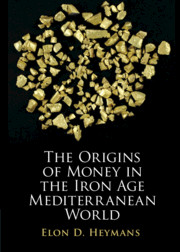Book contents
- The Origins of Money in the Iron Age Mediterranean World
- The Origins of Money in the Iron Age Mediterranean World
- Copyright page
- Contents
- Figures
- Maps
- Tables
- Preface
- Acknowledgements
- Author’s Note
- One Rethinking the Origins of Money
- Two Outline of an Approach to Money
- Three A Study of Iron Age Precious Metal Hoards
- Four Money in the Iron Age Southern Levant
- Five Money in the Iron Age Aegean
- Six Conclusion
- Appendix A Catalogue of Iron Age Precious Metal Hoards in Israel/Palestine
- Bibliography
- Index of Ancient Sources
- General Index
Five - Money in the Iron Age Aegean
Published online by Cambridge University Press: 17 September 2021
- The Origins of Money in the Iron Age Mediterranean World
- The Origins of Money in the Iron Age Mediterranean World
- Copyright page
- Contents
- Figures
- Maps
- Tables
- Preface
- Acknowledgements
- Author’s Note
- One Rethinking the Origins of Money
- Two Outline of an Approach to Money
- Three A Study of Iron Age Precious Metal Hoards
- Four Money in the Iron Age Southern Levant
- Five Money in the Iron Age Aegean
- Six Conclusion
- Appendix A Catalogue of Iron Age Precious Metal Hoards in Israel/Palestine
- Bibliography
- Index of Ancient Sources
- General Index
Summary
This chapter explores the different social contexts in which forms of money appear in the Iron Age Aegean world, and how these develop and converge in the emerging use of precious metal money before the spread of coinage. Early sanctuaries form such a context, where the deposition of metal votive offerings could reflect an increasing focus on organizing cult expenses. Another context is provided by compensation or wergeld payments, notable in the Homeric epics and a prominent focus of early written law. Next, emphasis is placed on the context of interregional and international trade. Through contacts with Levantine merchants Euboians adopted the use of precious metal money in the Geometric period, stimulating the active search for gold sources in the northern Aegean. From the mid-seventh century onwards, Greek efforts extended to the exploitation of silver sources, arguably stimulated by the opening up of contacts with 26th-dynasty Egypt. Preceding the production of silver coinage by more than half a century, silver trade with Egypt likely boosted the use of silver within the Aegean, which shortly after superseded gold as the preferred form of money.
- Type
- Chapter
- Information
- The Origins of Money in the Iron Age Mediterranean World , pp. 168 - 227Publisher: Cambridge University PressPrint publication year: 2021

